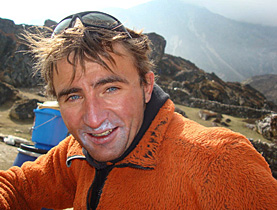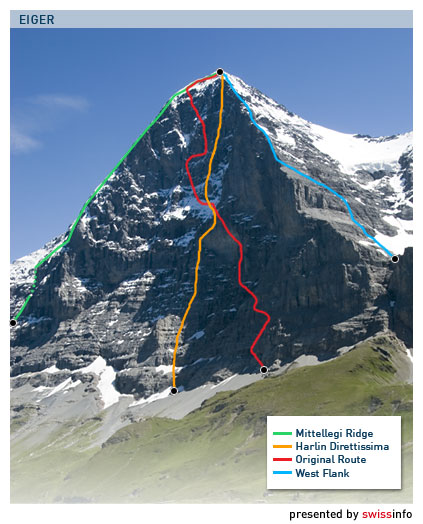
Breaking boundaries one perilous face at a time

Most climbers need two days to tackle the Eiger's treacherous north face, but if you're Ueli Steck, Switzerland's fastest alpinist, you can do it in less than three hours.
You wouldn’t spend all day on the north face of the Matterhorn, either. Steck bagged that one in one hour, 56 minutes, compared with the ten nerve-wracking hours it takes most people.
The north face of the mighty Grandes Jorasses near Chamonix, France? Steck ticked it off in a blistering two hours, 21 minutes.
The 33-year-old from the rolling Emmental in canton Bern is one of the world’s best free-soloists, the most perilous of all the climbing styles. He often tackles dangerous routes with no ropes or gear to guard against a fall. A single mistake can mean a horrific death.
“The strongest part of him is his focus,” said Stephan Siegrist, Steck’s friend and a climbing partner for ten years. “You have to be focused like that if you want to climb at that level.”
High-altitude humanitarian
For people who’ve never clung to the side of an airy cliff, it is difficult to understand exactly how high that level is. His ascents are tests of strength, endurance and mental acuity so demanding that only a handful of the world’s most elite climbers can do what he does.
Though climbing comes naturally to him, Steck also trains religiously for his climbs. He has a trainer who works with Olympic athletes and never misses a work out. As a result, Steck can do one-arm pull-ups from his fingertips and run for three hours right off the couch. On the rock he can claw his way up routes glazed with ice so steep and bare that the face can seem virtually blank.
In April he and Simon Anthamatten won one of mountaineering’s prestigious Piolets d’Or, or Golden Ice Axes, for a bold new ascent up the unforgiving north face of 6,500-metre Tengkampoche in Nepal.
The two were also recognised for scrapping their own expedition to try to rescue a stranger dying in the snow high on Annapurna last year.
“Quite often someone who climbs at the top level is totally self absorbed,” said Norman Croucher, a double-leg amputee from Britain who has climbed 8,000-metre peaks and presented Steck and Anthamatten with an award for their bravery in April.
“It’s nice to know that someone on the top end like that is also prepared to look after someone else.”
“One solution – climb”
Like many mountaineers, Steck is deliberate and quiet. He has a thin frame braided with swollen muscles. When he speaks he chooses his words like a tactician, making sure each is precise. Friends say that deliberateness is how he is able to make record-breaking climbs.
Steck swears that climbing spooky sections with no rope to catch a fall can actually be safe.
“Climbing the steep, exposed sections is not the dangerous part because there you are moving slowly, making sure each hold is good,” he said shortly before giving a slideshow presentation near Zurich on some of his feats.
“The dangerous part is when you are running up the slopes because there you are moving fast. If you trip or slip, you are done.”
Steck did nearly die a few years ago when a rock fell on his head at 6,000 metres, sending him tumbling to a glacier below. Miraculously he walked way.
“It opened my eyes,” he says. “You see how fast everything can happen. But it was important for me to understand that it was just bad luck and not that I had pushed too far.
“If you look at a situation high on a cliff and think this will be a bad place to fall, you have to focus or else you will fall. So there is only one solution – climb.”
From horizontal ice to vertical
Climbing wasn’t a Steck family pastime. Ice hockey was, and Steck, the youngest child of three boys, played hard as a left defender. Though he liked the game, it did not capture him as climbing eventually would.
“Hockey is a team sport whereas climbing is very individual,” he said. “This was really interesting to me. If you don’t make it to the top, it’s not someone else’s fault.”
Steck got his first shot at a summit when he was 12 years old after a friend of his father’s took him up a peak near his home in Langnau, a town of about 9,000 people in canton Bern. It was a “real alpine climb”, Steck said, with steep sections that the boy immediately led.
“I was so scared but this was actually very good for me,” he said. “From the beginning I have always climbed on lead.”
By the time he was 14, Steck was travelling around Switzerland on his own to climb. At 15 he went to Corsica where he tackled ever more difficult routes.
He started spending summers in Yosemite and worked at ski areas in winter to save more money for climbing. He started landing sponsorships and for the past four years he says he’s felt like a full-time professional climber, earning as much as a craftsman might.
“It’s my business now,” he says. “It’s become a regular job.”
New boundaries
Other climbers are often critical of speed climbers for aesthetical reasons. Reducing a mountain and all its natural beauty to a racecourse goes against the freedom of movement that so many climbers enjoy, they say.
“It’s certainly not my thing,” says Croucher. “But I think all forms of climbing should be welcomed.”
Even Steck says that when he races up a mountain it is not to be close to nature. “It gets media attention,” he says. “Sponsors like that.”
But after his first record ascent of the Eiger in 2007, followed by ascents of the Matterhorn and Grandes Jorasses between February 2008 and January 2009, Steck realised speed climbing could serve as a stepping-stone to break “new barriers” in climbing.
“To take these techniques and apply them to big mountains in the Himalayas, that’s where you can really break new barriers,” he says. “Sure, there is more risk doing what I do but it’s a better life.”
Tim Neville in Wetzikon, swissinfo.ch
Steck’s record ascents:
North face of the Eiger, Heckmair Route, two hours, 47 minutes (February 13, 2008)
North face of the Grandes Jorasses, Macintyre Route, two hours, 21 minutes (December 28, 2008)
North face of the Matterhorn, Schmid Route, one hour, 56 minutes (January 13, 2009)
Ueli Steck has actually broken the record for the fastest ascent up the north face of the Eiger twice, including his own. The first time he shaved 45 minutes off a record of four hours, 30 minutes, set by Christoph Heinz in 2003.
Then in February 2008, Steck pruned 58 minutes off his own time, climbing the north face alone in winter in a staggering two hours, 47 minutes, 33 seconds.
The Eiger Nordwand is particularly perilous because rocks and ice chunks rain down the face onto climbers below. The 1,800-metre high wall also acts as a backstop, trapping virulent storms even while better weather lingers over the surrounding area.


In compliance with the JTI standards
More: SWI swissinfo.ch certified by the Journalism Trust Initiative
















![The four-metre-long painting "Sonntag der Bergbauern" [Sunday of the Mountain Farmers, 1923-24/26] had to be removed by a crane from the German Chancellery in Berlin for the exhibition in Bern.](https://www.swissinfo.ch/content/wp-content/uploads/sites/13/2025/12/01_Pressebild_KirchnerxKirchner.jpg?ver=a45b19f3)











You can find an overview of ongoing debates with our journalists here . Please join us!
If you want to start a conversation about a topic raised in this article or want to report factual errors, email us at english@swissinfo.ch.